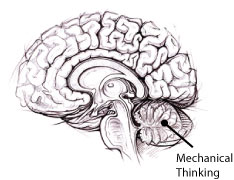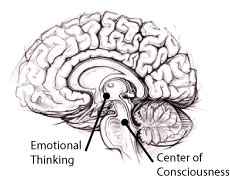Help Students Clear the Way for Critical Thinking
In order to get students to think critically, you need to help them break through their mechanical thinking and manage their emotional thinking.
What is mechanical thinking?
When students think mechanically, their brains are just repeating looped recordings of thought without considering them. For example, students might have the mechanical thought, “I'm not good at math.” It just crops up in their brains whenever they look at a math problem. Often that little mechanical loop doesn't even relate to reality.
Why do we think mechanically?

Mechanical thinking is useful for routine tasks like walking, riding a bike, keyboarding, driving, playing an instrument, and other activities that have become part of muscle memory. To learn any of these skills takes a lot of critical thinking, problem solving, and practice, but once the skill is learned, it is stored in the cerebellum at the base of the brain. Often a person can do something with great ease but can't explain how to do it to anyone else. The skill is no longer conscious. But to learn new skills, students need to think critically.
How can students break through mechanical thinking?
When students are thinking mechanically about a topic in school, they are recalling old ideas about it and are not engaging the material in a new way. Most often, mechanical thoughts manifest themselves in statements that shut down possibility. You can teach students to recognize such statements, stop them, and replace them with questions that open up possibilities:

Mechanical Thinking(statements that stop thought) |

Critical Thinking(questions that start thought) |
| “I'm not good at math.” | “How can I improve my math skills?” |
| “That's not the way Mrs. Jones taught us.” | “How many ways are there to do this?” |
| “There was only one reason for the Civil War.” | “What different factors led to the Civil War?” |
| “Current Events is boring.” | “How do events right now shape my future?” |
| “Our group never accomplishes anything.” | “Why is our group getting hung up?” |
What is emotional thinking?
When students think emotionally, they respond to an idea based on their feelings, positive or negative, rather than on critical thought: “I hate classical music.” When you challenge a student's emotional thinking, rationalizations result: “Why do you hate classical music?” “I don't know. I just don't like it. It's kind of primitive, isn't it? We've made advances in music, you know.” The student isn't really thinking critically but instead is letting thought be slave to emotion.
Why do we think emotionally?
Emotions help us respond appropriately to our environment. When we hear a dog barking viciously nearby, we feel fear, and our bodies pump adrenaline. We are ready to escape or attack. When someone we love gives us a gift, we feel gratitude, and our bodies feel completely different. We are ready to thank others and connect with them.

The limbic system, which is the center for emotion, sits atop the center of consciousness in the brain. Signals that come up from the spinal cord pass through this center of consciousness and bloom out through the limbic system before they can reach the cerebrum, where critical thinking occurs. For that reason, we think emotionally before we think critically. It's just the way the brain is designed. In order to engage objective, critical thinking, we need to manage our emotional thinking.
How can students manage emotional thinking?
Unlike mechanical thinking, emotional thinking cannot be simply stopped or replaced. Emotion is part of thought, so students can't manage it by denying it. However, you can teach students the following process for recognizing emotional thinking and consciously setting it aside in order to think critically.

Emotional Thinking(statements about feelings) |

Critical Thinking(statements setting emotion aside) |
| “I feel queasy about the lab because we have to dissect a cow's eyeball.” | “But I can set those feelings aside so that I can learn about the structure of the eye.” |
| “I love Edward from Twilight by Stephanie Meyer.” | “But for my review, I should focus on an important theme in the book instead of Edward.” |
| “I hate everything about war and wish we didn't have to learn about it.” | “But I need to learn about war to help prevent it, so I'll put my feelings aside.” |
| “Whenever the visiting fans cheer for their team, I get mad.” | “I should recognize that they want to win as much as we do, even if it is our homecoming.” |
| “I feel really nervous about our next gym unit, which is weightlifting.” | “But I can overcome my nerves because lifting weights will make me stronger.” |
Clearing the Way
Mechanical thinking is great for walking, eating, dancing, and other actions that require muscle memory. Emotional thinking is important for responding appropriately to our environment. But to think critically, students need to break through their mechanical thinking and manage their emotional thinking. By providing them the strategies above, you can help them think more deeply about any topic.
We want to hear from you! How do you help your students overcome mechanical thinking? How do you help them manage their emotions? Please write comments below.


Comments
Really like the 'train' of subsequent thinking
I really like how you describe the mechanical thinking and how it leads and relates to emotional thinking and subsequently the formation of critical thought. Having teenagers myself, I find often that they think in absolutes, but with a bit of probing and questioning, are able to build some critical and creative thought around a specific point.
Teens and Absolutes
Thanks so much for the comment below!
Yes, the teen mind does like black-and-white situations. I remember being a teen and wondering why my parents were so wishy washy. Now I understand that reality has many shades of gray, and we need critical thinking to parse through them. Thanks so much for your comment!
I Love the Comment Below!
The comment below is a very insightful demonstration of how to break through mechanical thinking and manage emotional thinking. Nicely done!
Much of our day-to-day activity is ruled by mechanical and emotional thinking. I often have to stop a thought that just pops up and doesn't represent reality. Just this morning, I caught myself thinking "I'm so tired," when the reality was that I got to sleep in an hour more than usual and even had to struggle to stay asleep for that hour. I stopped the thought, "I'm not tired. I've had plenty of sleep. What am I going to do today?"
Yes, I think if we become aware of our own mechanical and emotional thinking and learn not to be ruled by such thoughts and feelings, we'll be well equipped to help students do the same.
Thanks so much for your comment!
Thanks for a very interesting
Thanks for a very interesting article. I'm beginning to believe more and more in the importance of not expecting students to do anything I haven't tried or experienced myself, so here goes ...
I'm tempted to just read and RT your article because I can do that without taking any emotional risk and stop uncomfortable thoughts of responding that would involve setting emotion aside.
I'm afraid to say what I think because I might be wrong - Emotional thinking. I think I've got something to say but I might be wrong - Mechanical thinking.
Posting my comment on your blog - Critical thinking.
I think the best way I can help my students is by breaking through my own mechanical thinking and mananaging my own emotional thinking so I know exactly what I'm asking them to do.
Post new comment